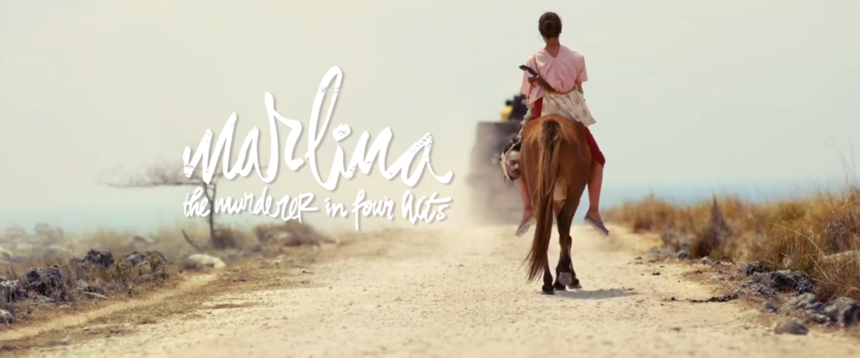Sitges 2017 Review: MARLINA THE MURDERER IN FOUR ACTS, a Traditional Western Story Told in a Fresh Way
Mouly Surya's full fledged plunge into the genre is nothing shy of magnificent.

In making a film, any film, it is nearly essential to have an image or scene that the audience takes away with them. Think about a film you love, and get it in your minds eye, and that is what will first spring to mind.
Indonesian neo-Western Marlina The Murderer In Four Acts has a wealth of such memorable scenes and compositions, enough to fill more than a few films. The standout is a long shot of the heroine slowly appearing into the view on horseback, no saddle, rising out of an endless range of rolling foothills, rippled by heat waves, and carrying a severed head wrapped up in rope like a tote bag.
In the fine tradition of exporting the Western into new countries and modern modes of expression, Mouly Surya's full fledged plunge into the genre is nothing shy of magnificent. There is an exceptional eye for detail and framing that set the stage coupled with a honed suspensful patience in paying of each of its four titular acts. For those keeping score, they are Robbery, Journey, Confession, Birth.
The plot, as with most Westerns -- be they of the Classic Fordian variety, Revisionist, Spaghetti or otherwise -- is a exercise in straightforwardness, but a stark, simple narrative provides opportunities to focus on the details and the texture of the Indonesian setting.
The film was written and directed by a women and stars women who are not simply feminized versions of male warriors, but fully fleshed-out people, while the male characters in the picture are either deadbeats or simply dead. Surya manages to rebuild the basic notions from the ground up with a female perspective.
The film was shot in the poorest district of Indonesia (not exactly the world’s wealthiest country to begin with) in the 21st century, so there are buses instead of stage coaches, motorcycles mixed with horses and livestock, and even cellular phones. And yet, things still have that barren frontier essence of 19th century American West. On occasion, a vast sparkling ocean twinkles in wide cinemascope background. This is the type of big cinema canvas enveloping more intimate surroundings that Tarantino attempted to only muted success with The Hateful Eight. He might take a note or two from Surya.
A rape (and robbery) in the opening act of picture sets things in motion, but is noteworthy in that what is often a rote, violent purpose for an easy buy-in from the audience is realized and executed in a way I have not seen before. The mode here is pragmatism and resourcefullness, not cheap drama or manufactured rage.
Marsha Timothy plays Marlina with a stoicism that might seem a familiar echo of men with no name, but hers is a more subtle reaction to the world around her: one where the police play ping-pong and smoke cigarettes instead of enforcing the law. There is no money in this isolated and poverty stricken part of the country for an ambulance or investigation, or even a rape-kit to gather the necessary evidence, only empty bureaucracy and judging eyes. And all this as the countryside is clearly crawling with lazy and belligerent goons, and the occasional ghost of the dead.
A subplot involves a very pregnant woman, Novi, who is a week past her due date, and trying to locate her husband who has disappeared into his work further up the country. He is not answering his phone, enraged because he is convinced there is something wrong to be holding up the birth. Her journey eventually ends up intertwined with Marlina’s in a way that makes them the most unlikeliest of travelling gunslingers. There are more than a few pee breaks along the way.
Absent any opportunity to leave the district or receive any help, they can only return to the scene of the crime and deal with things themselves. Marlina's husband's body, still bundled up a funeral posture in the common room of their farmhouse, functions almost like a totem or silent, impotent guardian. How Surly moves her camera around composed interior and exterior spaces is a real pleasure, even as the film hits some splattery action beats.
A family trying to round up a necessary dowry for a wedding, and a young girl who runs a satay reastaurant for her parents, round out a collection of striving souls who exist in a fleshed out and populated world that feels lived-in even as it is being mythologized in the way that westerns so often do.
Accompanying all of this is a superbly twangy score that pays honour to the great Ennio Morricone, without feeling in any way derivative. The entire package here, iconic images and all, was labelled a Satay Western upon its bow at this year’s Cannes, and it is a slice of heaven for fans of the genre, effortlessly and sharply straddling the No Man’s Land between the arthouse and grindhouse.

Do you feel this content is inappropriate or infringes upon your rights? Click here to report it, or see our DMCA policy.






